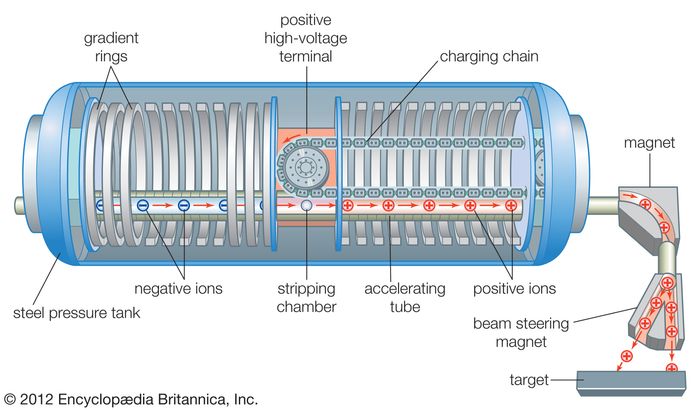In the fascinating realm of particle physics, particle accelerators stand as monumental achievements, unlocking the enigmas of the universe at the most fundamental level. Among the myriad factors that contribute to their functionality, high voltage emerges as a cornerstone, playing an indispensable role in modulating the behavior of charged particles. Understanding this role not only deepens appreciation for the subtleties of scientific inquiry but also transforms the way we perceive the universe itself. This article endeavors to delineate the pivotal significance of high voltage in particle accelerators, elucidating its multi-faceted contributions and implications.
At the heart of any particle accelerator lies the endeavor to propel charged particles, be they protons, electrons, or ions, to velocities approaching that of light. High voltage serves as the driving force behind this acceleration, imparting kinetic energy to particles that would otherwise remain in a state of relative quiescence under ordinary conditions. The fundamental principles governing this acceleration can be traced back to the interplay between electric fields and charged particles. When high voltage is applied across an electrode, a potential difference is created, leading to the establishment of an electric field that propels charged particles towards higher velocities.
Particle accelerators can be categorized into two primary types: linear accelerators (linacs) and circular accelerators. Each type employs high voltage in distinctive yet complementary manners. In linear accelerators, particles traverse a straight path where they are successively accelerated through a series of oscillating electric fields. Here, high voltage is indispensable, as it directly influences the energy gains per unit length, facilitating rapid acceleration over short distances. Conversely, in circular accelerators, such as synchrotrons, particles are propelled in circular paths, where high voltage is utilized to maintain their energy levels as they repeatedly traverse the accelerator ring. The distinction between these two modalities demonstrates the versatility of high voltage in enhancing both the efficiency and efficacy of particle acceleration.
A remarkable aspect of high voltage in particle accelerators is its correlation with energy output. As high voltage increases, particles gain greater kinetic energy, leading to more energetic collisions and, consequently, more fruitful experimental outcomes. This principle explains the phenomenal discoveries made in prominent accelerators, such as the Large Hadron Collider (LHC), where transformative discoveries like the Higgs boson have been made possible by harnessing high voltage to reach unprecedented energy levels. Such findings not only bolster the Standard Model of particle physics but also invite contemplation about the very fabric of reality, ultimately inspiring a paradigm shift in our understanding of the cosmos.
The role of high voltage extends beyond mere acceleration; it is also crucial in the realm of beam dynamics—an area dedicated to optimizing and maintaining particle beams. Inadequate voltage can lead to beam instabilities, resulting in phenomena such as beam loss or dispersion, which can drastically undermine experimental integrity. Therefore, the meticulous calibration of high voltage settings is essential for maintaining beam coherence and integrity, enabling precise measurements and explorations. Engineers and physicists alike invest considerable effort into understanding the dynamics of particle beams, revealing that high voltage is not merely an auxiliary component but a critical element that demands rigorous attention.
Another fascinating dimension of high voltage’s role in particle accelerators is its influence on the interactions between particles and various materials. When high-energy particles collide with matter, they can produce secondary particles, gamma rays, and other forms of radiation. This process has significant implications, particularly in fields such as materials science, nuclear physics, and even medicine, where particle accelerators are utilized for applications such as cancer treatment and radiographic imaging. Here, high voltage becomes intertwined with the possibilities of technological innovation, presenting opportunities for breakthroughs that can impact human health and well-being.
Moreover, the intricate mechanisms of high voltage in particle accelerators bring to the forefront essential considerations regarding safety and operational protocols. The energy levels generated by high voltage can be immensely hazardous. Consequently, rigorous safety measures are paramount in preventing unintended exposure to radiation or electrical hazards. Engineers and safety officers develop comprehensive strategies, training, and protocols to maintain a secure operational environment. This aspect highlights a critical intersection of scientific advancement with ethical considerations, illuminating the responsibility that accompanies the quest for knowledge.
As we delve deeper into the implications of high voltage in particle accelerators, we encounter profound philosophical queries regarding the quest for knowledge itself. The capacity to manipulate and control particles at such extravagant energy levels evokes reflection on the nature of human curiosity and the unceasing endeavor to unlock the mysteries of the universe. Each breakthrough enabled by high voltage not only deepens the understanding of fundamental forces but also prompts further questions that reverberate through scientific discourse, illustrating the intricate tapestry of inquiry that characterizes modern physics.
In conclusion, high voltage serves as a pivotal element in the operation of particle accelerators, facilitating the acceleration of charged particles, enhancing beam dynamics, enabling groundbreaking discoveries, and presenting ethical challenges. This multifaceted role underscores the significance of high voltage not only within the confines of particle physics but also in broader scientific contexts. Engaging with these concepts invites curiosity, propelling future generations of scientists and thinkers to explore the cosmos. High voltage, in all its complexity, exemplifies the dynamic interplay of energy, matter, and the relentless pursuit of knowledge that defines human inquiry.












